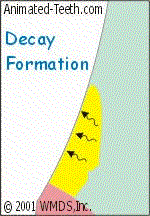Heal your own teeth: Remineralization of tooth enamel
Your breath does the work!!!


Remineralization is the process of restoring mineral ions to the tooth structure, and can be compared to replacing the missing links in a chain. The lost mineral ions must be replaced with ions of the same shape, size and electrical charge. Remineralization involves carbon dioxide from breath and water from saliva to create a mild, unstable carbonic acid that is at the core of the natural remineralization process. Minerals in saliva present from food are dissolved by the carbonic acids. In addition, carbonic acid quickly and easily converts to carbon dioxide and water. When this happens, the dissolved mineral ions precipitate out as solid mineral ions again, but not always as the original mineral molecules. If a particular mineral ion is near a demineralized portion of the hydroxyapatite crystal that requires that ion, the ion is incorporated into the dental enamel. Though natural remineralization is always taking place, the level of activity varies according to conditions in the mouth. In fact, for remineralization to proceed, six conditions or events must occur at the same time:
• Sufficient minerals must be present in the saliva. Food is the principal source of minerals for the teeth, therefore an adequate diet and sufficient time spent chewing (this transfers minerals to the saliva) is vital.
• A molecule of carbonic acid must be produced. A very small fraction of the carbon dioxide from the breath is converted to carbonic acid.
• The carbonic acid molecule must be produced in proximity to a mineral molecule, which then dissolves into its ionic components.
• This all has to occur in proximity to a demineralized spot in the hydroxyapatite latticework that requires the exact mineral ion.
• The demineralized spot has to be clean and accessible so the mineral ion is attracted to the “hole” in the lattice by the opposite electric charges of the ion and the “hole.” Many different ions have the correct charge, but only the correct ion has the correct shape and size to fit into the “hole.”
• The carbonic acid must convert to carbon dioxide and water before any of the above circumstances change. When this happens, a mineral ion is precipitated out of solution into the structure of the enamel.1,2
Since natural remineralization is frequently inadequate to maintain strong enamel, especially in today’s world of processed foods and refined sugars, the natural remineralization process needs to be augmented. Remineralization must be enhanced, or demineralization must be retarded.1,2
There are currently three technologies that offer claims of remineralization:
• Recaldent, found in GC America’s PROSPEC MI paste and Trident chewing gum
• Amorphous calcium phosphate (ACP) found in Arm & Hammer’s Enamel Care Toothpaste, Discus Dental’s Nite White bleaching gel and Premier Dental’s Enamel Pro polishing paste
• SensiStat, found in Ortek Therapeutic’s Proclude and Denclude products1,2,3
See the related boxes in this article for more information.
Also worth mentioning is a new technology called NovaMin, a synthetic mineral composed of calcium, sodium, phosphorus and silica, the driving mechanism that binds to the tooth surface. The sodium buffers the pH to allow for precipitation of crystals onto the tooth surface. There is a rapid and continuous release and deposition of a natural crystalline hydroxyl-carbonate apatite (HCA) layer that is chemically and structurally the same as tooth mineral. SootheRx by OMMII and Sunstar Butler’s NuCare prophy paste both contain NovaMin.7 Patient care strategies
One of my colleagues who works with the JP Institute told me that as a trial, she placed two of her patients on SootheRx. Both of these patients suffered from such severe sensitivity that they could not tolerate a continuing care visit. The protocol for SoothRx is use twice a day for two weeks followed by once a week for six months. After only two weeks, the patients returned for continuing care with complete relief. By using SootheRx once a week, the patients continue to be sensitivity free.
There are several ways to treat a caries infection, most of which involve combined home use of chlorhexidine and fluoride. With remineralization therapy, areas in the patient’s mouth that are demineralized and run the risk of cavitating have a good chance of remineralizing before cavitation occurs. Of course, anything that can be done to assist the patient in reversing the demineralization process is of significant value.
Since demineralization occurs when the tooth undergoes an acid challenge, the first step is to reduce the frequency of that challenge. Nutrition and diet are a chief concern, especially today where we encounter more processed than fresh food. Telling patients of the importance of fresh fruits and vegetables, which provide the minerals our bodies need to naturally remineralize the tooth structure, should be part of the recall or continuing care hygiene protocol.
For those who have active decay or areas of demineralization (white spots), daily use of a chewing gum with ACP is highly recommended, in addition to a healthy diet. Trident Advantage, Trident for Kids, and Trident Whitening all contain appropriate amounts of ACP. Two sticks of gum should be chewed for five minutes, five times per day to assist in the remineralization process and maintenance of healthy saliva flow.6 My current patient recommendation is to chew the ACP gum for five minutes after breakfast, after lunch, mid-day, after dinner and before bed. This accomplishes the suggested “five for five” per day regimen to remineralize the affected areas.
Patients may use MI paste at home. They simply brush, floss, then rub the MI paste on the demineralized areas with their fingers. No rinsing is needed. MI paste is also well utilized during a hygiene visit when applied with the rubber cup in the same way as polishing, without rinsing afterward.3,4 For ongoing home use, the clinician should recommend Enamel Care Toothpaste with ACP by Arm & Hammer. Replacing daily use of regular toothpaste with ACP makes the calcium and phosphate readily available for use in the saliva. Keep in mind the need for fluoride use if toothpaste with fluoride is omitted.8
For in-office use, a polishing paste containing one of the remineralization technologies should be used with each periodontal maintenance or continuing care appointment. Either Enamel Pro or Proclude will meet the in-office requirements.
The greater our ability to arrest disease and the more we take advantage of remineralization technologies, the better our patients are served. Clinicians should research these products and their application for home use by the patient, as well as professional use. Your patients will be glad you did.
Comments
I've been chewing on magnesium hydroxide tablets (mint flavored antacids, Walgreens brand) right after I eat, and I've been noticing, just in the past WEEK, the dental caries I have near the gumlime are starting to fill in!!! I'm shocked and amazed. Also, my tooth pain has gone.
So: Neutralize the acid in your mouth as SOON as it gets in there (eating, drinking, etc) and you'll see a difference. Your gums will be tighter too!!


